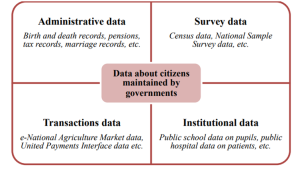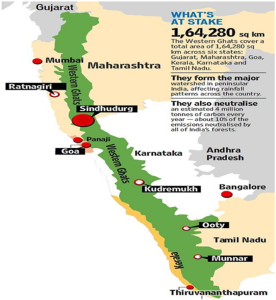Mains – 25th Nov 23
India’s Statistical System
Why in news?
- Recently, a member of the PM’s Economic Advisory Council argued that national surveys are based on unsound frameworks and systematically underestimate India’s development.
- In response, the Government of India has appointed Standing Committee on Statistics (SCoS) under the chairmanship of Pronab Sen, former Chief Statistician of India to review the methodology of the National Statistical Organisation (NSO).
India’s Statistical System
- India has a federal structure of Government and the Indian Statistical System functions within the overall administrative set up of the country. : The subject ‘Statistics’ is covered in Entry 94 of the Union List (List – I) and Entry 45 of the Concurrent List (List – III).
- The Indian Statistical System may be treated as both decentralized and centralized system. For example, the large-scale statistical operations conducted all over the country like Population Census, Economic Census, Agricultural Census and Livestock Census, as well as nation-wide sample surveys including the Annual Survey of Industries and the Socio-Economic surveys is the responsibility of Central agencies. Similarly, compilation of national accounts, preparation of all-India Prices and Industrial production indices are also Central activities.
- In the case of States, the State statistical organizations collect and generate data on a number of variables. The State Directorates of Economics and Statistics (DESs) carry out the responsibility of coordination of all statistical activities at the State level and keeping liaison with the MOSPI for the purpose of maintaining uniformity and consistency in the data produced and consolidated at different levels.

Ministry of Statistics and Programme Implementation
- The MoSPI came into existence as an Independent Ministry in 1999 after the merger of the Department of Statistics and the Department of Programme Implementation.
- The Ministry has two wings, one relating to Statistics and the other Programme Implementation.
- The Statistics Wing called the NSO consists of the Central Statistical Office (CSO), the Computer centre and the National Sample Survey Office (NSSO).
- Besides these two wings, there is National Statistical Commission (NSC was created through a resolution) and one autonomous Institute – Indian Statistical Institute – an institute of National importance.
National Statistical Commission
- It was set up in 2006 on the recommendations of the Rangarajan Commission.
- It is an autonomous organization works under Ministry of Statistics and Programme Implementation.
- 1 Chairman + 4 Members and 1 ex-officio member.
NSO
- Government had merged National Sample Survey Office and Central Statistical Office and created National Statistical Office – NSO.
- NSO was first envisaged by Rangarajan Commission to implement and maintain statistical standards and coordinate statistical activities of Central and State agencies as laid down by the National Statistical Commission (NSC).
- NSO is headed by Secretary (Statistics and Programme Implementation).
Functions
- Acts as the nodal agency for planned development of the statistical system in the country.
- Coordinates the statistical work in respect of the Ministries/Departments of the Government of India.
- Prepares national accounts as well as publishes annual estimates of national product.
- Maintains liaison with international statistical organisations, such as the United Nations Statistical Division (UNSD), Economic and Social Commission for Asia and the Pacific (ESCAP), IMF, ADB, FAO, ILO, etc.
- Compiles and releases the Index of Industrial Production (IIP) every month in the form of ‘quick estimates.
- Conducts the Annual Survey of Industries (ASI).
- Provides statistical information to assess and evaluate the changes in the growth, composition and structure of the organised manufacturing sector.
- Organises and conducts periodic all-India Economic Censuses and follow-up enterprise surveys.
Recently, the Ministry of Statistics and Programme Implementation (MoSPI) has formed a new Standing Committee on Statistics (SCoS) to advise on official data generated by the National Statistical Office (NSO). This panel, chaired by former National Statistical Commission (NSC) chief and India’s first Chief Statistician Pronab Sen, will replace the Standing Committee on Economic Statistics (SCES) that was formed in 2019 to advise on economic data.
Issues with India’s Statistical System
- In India, policymakers typically rely on the estimates of sample surveys of households to assess previous policies or to frame new policies. But there is concern over non-frequent nature of some of these surveys (in particular, the household consumption expenditure survey).
- Some experts have raised concerns over the outdated survey methodologies used in national surveys, such as the National Sample Survey (NSS), National Family Health Survey (NFHS), and Periodic Labour Force Survey (PLFS), leading to systematic underestimation of India’s development. They argue that this archaic methodology has failed to capture reality in the recent past as the “Indian economy has been incredibly dynamic in the last 30 years”.
- Critics argue that national surveys like NFHS exhibit a rural bias, overestimating the rural population due to heavy reliance on outdated Census data. Using projected population estimates, it is found that nearly all major surveys in India that were conducted post-2011 and used the Census 2011 for the sampling have overestimated the proportion of the rural population significantly.
- The credibility of some of NSO’s data has been questioned.
- For example, in 2019, the government decided to junk the results of two major NSSO household surveys carried out to assess the employment and consumption expenditure levels in Indian households due to data quality issues.
- Data showing contemporary ground realities is unavailable.
- For example, India’s key economic indicators such as retail inflation, GDP or even the extent of poverty (revised), continue to be based on the 2011-12 numbers.
- It compels the government to rely on proxy data such as Employees’ Provident Fund (EPF) account numbers to gauge employment trends and the National Family Health Survey to assess poverty levels.
- UN Economic Commission for Europe states that on an average US spends $11 per person per year on collecting data. In contrast MoSPI has a budget less than Rs. 8 per Indian per year.
What can be done?
The Ministry of Statistics & Programme Implementation (MoSPI) has formulated a Draft “National Policy on Official Statistics (NPOS)”
This policy promotes the use of the latest technologies and lays down a road map towards modernised data collection and timely dissemination of information. • The policy reinforces the United Nations Fundamental Principles of Official Statistics (UNFPOS) (India adopted the UNFPOS in 2016).
- Creation of Integrated Data System (IDS): An IDS led by MoSPI would seamlessly interlink data sets and enable interoperability among different data producing systems at the National and State/UT levels.
- Key statistical products, such as GDP, price indices, SDGs, etc., are to be designed as core statistics.
- It encourages periodic reviews of statistics, documentation of steps involved, alignment of data products with the Data Governance Quality Index of NITI Aayog, and application of advanced technological tools.
Madhav Gadgil and Kasturirangan Reports
Why in News?
A landslide in Maharashtra’s Raigad district claimed 27 lives, flattened an entire village, and brought back into focus the conservation of the Western Ghats. In this context, Madhav Gadgil Committee report was mentioned.

Western ghat
- It is a mountain range that covers an area of 160,000 sq Km in a stretch of 1,600 Km parallel to the western coast of the Indian peninsula.
- It traverses through the states of Gujarat, Maharashtra, Goa, Karnataka, Kerala and Tamil Nadu.
- It is a UNESCO World Heritage Site and is one of the 36 biodiversity hotspots in the world.
- The forest in the Western Ghats has been severely fragmented due to human activities, especially clear-felling for tea, coffee, and teak plantations.
- In 2010, the Union Environment Ministry appointed the Western Ghats Ecology Expert Panel (WGEEP), to be chaired by ecologist Dr Madhav Gadgil.
Major Recommendation of Dr Madhav Gadgil

- 64% of Western Ghat as Ecologically Sensitive Area.
- Almost all development activities like mining, construction of thermal power plants and dams were to along in ESZ-1.
- In all zones, genetically modified crops should not be allowed.
- Bottom-up approach towards conservation.
- Establish Western Ghats Ecology Authority under EPA 1986.
There was resistance from various states especially Kerala. In 2012 Dr K Kasturirangan Committee was appointed.
Major Recommendation
- Only 37% as Ecologically Sensitive Zone.
- It also split the Western Ghats into cultural (human settlements) and natural (non-human settlements) regions. It was suggested that cultural lands be designated as an ESA.
- 3 categories:
- Red List: ban on mining, stone quarrying, thermal plants etc.
- Orange Category: Permission required.
- Green Category: Agri and horticultural activities.
In 2017, the Environment Ministry demarcated an area of 56,285 sq. Km in the Western Ghats as ESA as opposed to the 59,940 sq. Km recommended by the Kasturirangan committee.
